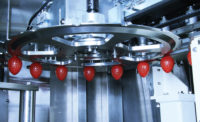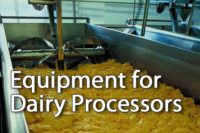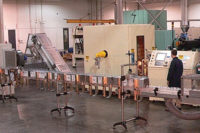When it comes to plastic milk cartons, dairies have choices. They can buy blow-molding equipment to make gallon and half-gallon bottles themselves. They can outsource the task to a supplier who sets up an on-site shop. Or they can buy empty jugs and have them trucked in.
Anderson Erickson Dairy, Des Moines, Iowa, is one dairy that blows its own bottles. After molding, excess resin is trimmed from bottles (and re-melted for use the next time around), which are tested for leaks and are then conveyed to the filling room. No sanitizing is required.
AE Dairy COO Warren Anderson told Dairy Foodsthat it owns and operates its blow-molding equipment because it prefers to maintain control over the production process as much as possible. Dairy Foodshas visited other dairies that choose to contract with blow-molding companies, which either operate the equipment inside the dairy plant or in a neighboring space.
Besides the convenience of not having to wait for bottle delivery, on-site blow molding offers a sustainability factor. Resin or preforms that will be converted into thousands of jugs and bottles are delivered to the dairy plant, rather than empty bulky bottles, which is akin to shipping air.
By now, blow molders have eliminated all the excess gram weight from bottles without significantly compromising their integrity (meaning leaks and dents), said Robert Spagnoli, the mold business unit manager for Uniloy, a Tecumseh, Mich.-based equipment supplier.
Another supplier, Plastic Technologies Inc., has shown its commitment to source reduction by creating modular systems which produce food grade recycled PET, known as rPET, said Ron Puvak, director of marketing and new business development, for the Holland, Ohio-based company. “These small footprint systems promote a local ‘collect, convert, consume’ approach to recycling,” he said.
“To help companies make informed decisions on how their packaging impacts the environment, PTI provides comprehensive evaluations on components such as additives, coatings, labels and resins. Extensive analysis can help you understand the environmental impact and recyclability potential of your additive/material combinations,” Puvak said.
Stretch blow-molding equipment requires a significant amount of compressed air and electricity to produce bottles, according to PTI.
“The key to creating a successful energy reduction program is to consider air delivery and air demand requirements at the same time. In the past, companies have tended to focus on these as separate areas and not in concert with one another. Using a systems approach is the key to optimizing operational improvements,” said Donald Miller, vice president, technical services, PTI.
In order to custom design an energy-savings plan, PTI does a multistep analysis of all bottle manufacturing stages. This includes bottle production (preform, bottle, relationship between the two and production platform); process purpose (package, quality and optimization of process and line efficiency); machine conditions/capabilities (supply and quality of air); blowing cycle review; oven control setup and configuration; process development and package performance validation.
Besides addressing sustainability issues, equipment makers are looking at plant productivity and efficiency. They say that the new design of blow molders allows for faster changeover time when dairy processors switch from making half-gallon jugs to gallon jugs. And suppliers’ services go beyond selling the equipment itself. Puvak said PTI helps dairies create commercially viable packaging structures and find solutions to challenging packaging issues. Its capabilities include package design, rapid prototyping, material evaluation and preforms.
In October, PTI announced a temperature probe for preforms that are used to produce bottles. The company called the tool “an asset” for dairies to improve their bottle-making efficiency. The tool measures the preform’s interior temperature. This is an important new capability, according to PTI, because traditional methodologies only measure the exterior temperature. The probe also can be used to identify process changes during routine operation and troubleshoot heat-related issues.
Equipment makers exhibit their wares
At the Emballage exhibition in Paris this year, RPC Emballages Moirans launched a new barrier process for blow-molded containers and RPC Superfos showed the latest decoration advances for its Paintainer. The RPC Superfos division showed its new Easy
Snackingsnack pack, available in two designs: one with a spoon in the lid and one with a higher lid, with room for both a crunchy topping and the spoon. There are two sizes —210 milliliters or 300 milliliters (about 7.1 and 10.1 ounces, respectively).
In June, Velocity Equipment Solutions, New Castle, Pa., said it completed two new technologies for extrusion blow molding of HDPE containers. The creation of the new technologies completes a three-year R&D effort carried out in cooperation with Velocity’s client Nampak Plastics Europe Ltd., a producer of dairy bottles in the United Kingdom.
The technology not only provides an owner a platform with a lower operating cost, but also the quick-change capabilities can eliminate the need for multiple production lines to produce multiple containers. This lowers an owner’s capital outlay, said Velocity Equipment President Tom Blaszkow in a statement.
The first technology is the all-electric reciprocating blow-mold machine. This machine uses electro-mechanical actuators to replace the hydraulic cylinders, pumps and actuators. Ball splines, thrust assemblies and all hydraulic components (which are common fail points) have been eliminated, according to Velocity Equipment. The machine was specifically designed for Nampak Plastics to be changed within an 8-hour shift from a 4-pint (2.3 liter), 35-gram bottle on 10 heads to a 2-pint (1.1 liter), 22-gram bottle on 12 heads.
Velocity Equipment’s second technology is a high-speed rotary impact trimmer capable of speeds up to 160 bottles per minute. With drive mechanics located above the spindles, the underside is completely open for the scrap-handling funnel. Also, although the trim tooling travels in a rotary motion the actual trimming is a conventional impact trim. The machine achieves high speeds and a wide operating window.
Find more suppliers of blow-molding equipment in the Dairy Foods Buyers Guide (July 2014 issue and online).




